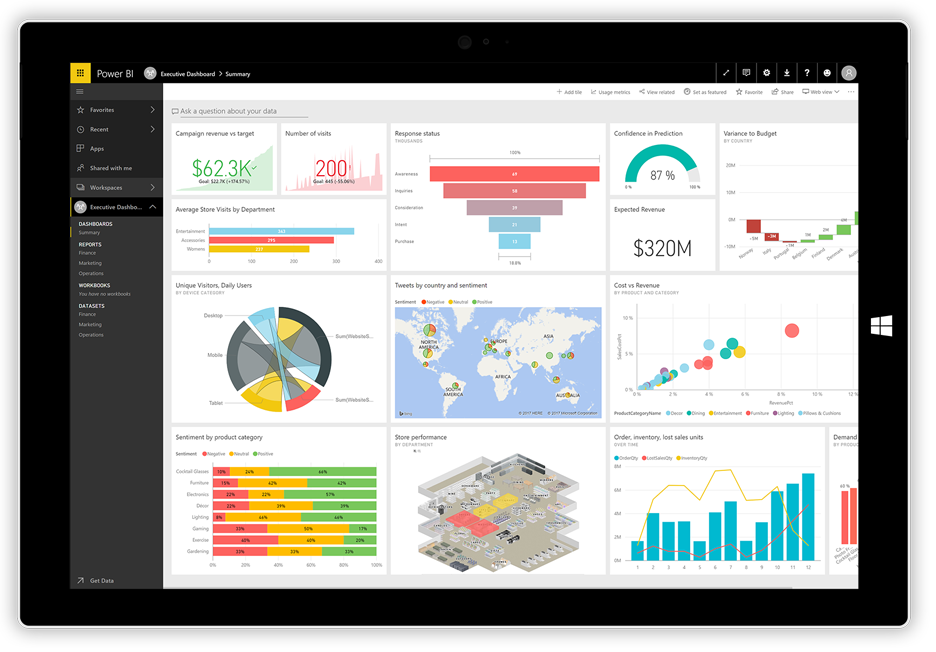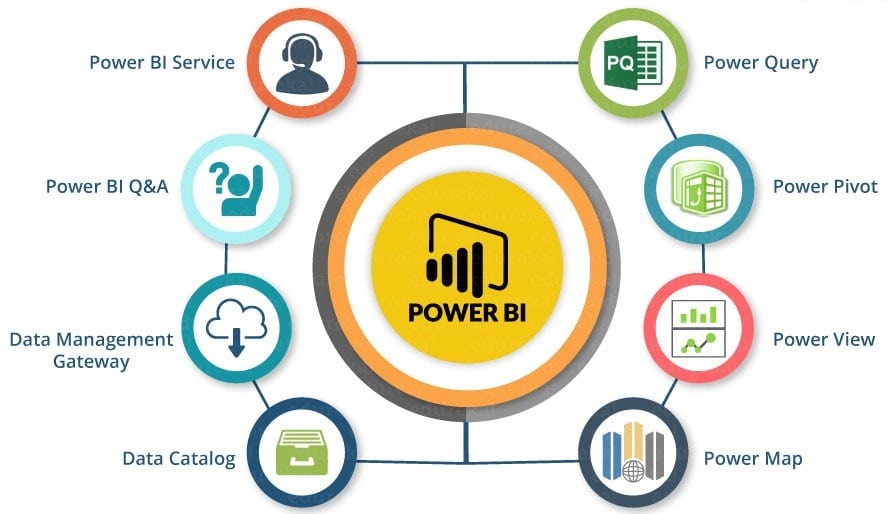
Power BI is a cloud-based business analytics solution from Microsoft that enables users to visualize and analyse data at a much faster and more efficient rate. It allows users to view to an extensive range of data through interactive reports and compelling visualizations that help bring data to life.
For organizations that are looking to gain a better insight into their business, competition, and customers, while keeping pace with the constant flux of marketing conditions – this business intelligence solution might be worth considering.
Power BI provide executive dashboards for administrators or managers, giving management more insight into how departments are doing.

Who uses Power BI?
Though Power BI is a self-service BI tool that brings data analytics to employees, it’s mostly used by data analysts and business intelligence professionals who create the data models before disseminating reports throughout the organization. However, those without an analytical background can still navigate Power BI and create reports.
Microsoft Power BI is used by both department representatives and management, with reports and forecasts created to aid sales and marketing representatives, while also providing data for management on how the department or individual employees are progressing toward their goals.
In addition, Power BI offers an admin portal for administrators to help configure the implementation of Power BI, as well as usage monitoring and licenses.
Power BI components
Power BI consists of a collection of apps and can be used either on desktop, as a SaaS product or on a mobile device. Power BI Desktop is the on-premises version, Power BI Service is the cloud-based offering and mobile Power BI runs on mobile devices.

The different components of Power BI are meant to let users create and share business insights in a way that fits with their role.
Included within Power BI are several components that help users create and share data reports.
- Power Query: a data mashup and transformation tool
- Power Pivot: a memory tabular data modelling tool
- Power View: a data visualization tool
- Power Map: a 3D geospatial data visualization tool
- Power Q&A: A natural language question and answering engine
Additionally, there are dozens of data sources that connect into Power BI, ranging from files (Excel, PDF, SharePoint Folder, XML), databases (SQL Server Database, Oracle Database, IBM databases, Amazon Redshift, Google BigQuery), other Power BI data sets, Azure data connections and many online services (Dynamics 365, Salesforce Reports, Google Analytics, Adobe Analytics, Facebook and others).
Key features of Power BI
Microsoft has added a number of data analytics features to Power BI since its inception and continues to do so. Some of the most important features include:
- Artificial Intelligence — Users can access image recognition and text analytics in Power BI, create machine learning models using automated machine learning capabilities and integrate with Azure Machine Learning.
- Hybrid deployment support — This feature provides built-in connectors that allow Power BI tools to connect with several different data sources from Microsoft, Salesforce and other vendors.
- Quick Insights — This feature allows users to create subsets of data and automatically apply analytics to that information.
- Common data model support — Power BI’s support for the common data model allows the use of a standardized and extensible collection of data schemas (entities, attributes and relationships).
- Cortana integration — This feature, which is especially popular on mobile devices, allows users to verbally query data using natural language and access results, using Cortana, Microsoft’s digital assistant.
- Customization — This feature allows developers to change the appearance of default visualization and reporting tools and import new tools into the platform.
- APIs for integration — This feature provides developers with sample code and application performance interfaces (APIs) for embedding the Power BI dashboard in other software products.
- Self-service data prep — Using Power Query, business analysts can ingest, transform, integrate and enrich big data into the Power BI web service. Ingested data can be shared across multiple Power BI models, reports and dashboards.
- Modelling view — This allows users to divide complex data models by subject area into separate diagrams, multiselect objects and set common properties, view and modify properties in the properties pane, and set display folders for simpler consumption of complex data models.
How to use Power BI
Power BI Desktop is where analysts and other users can create data connections, data models and reports. The Power BI service is where those reports can be shared, so other users can view and interact with the reports.
Building a Power BI report begins by connecting data sources. Users then query the data to create reports based on their needs. The report is published to Power BI Service and shared so cloud and mobile users can see and interact with the report. Permissions can be added to give colleagues the ability to edit reports or create dashboards or limit their ability to edit.

Power BI cost
There are three levels of Power BI for users: Power BI Desktop, Power BI Pro and Power BI Premium. The desktop version is free, while the Pro model costs ₹660 per user, per month. Pricing for Power BI Premium depends on the size of the deployment and user amount.
To learn more about how Power BI can benefit your business, Let’s CONNECT!











